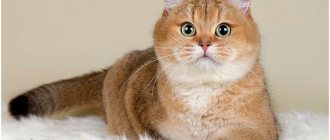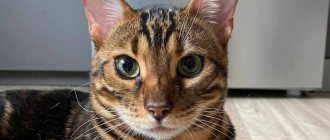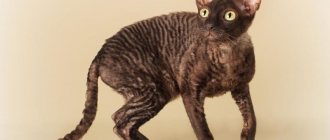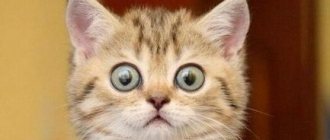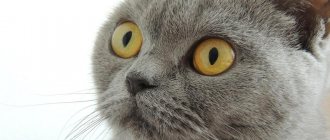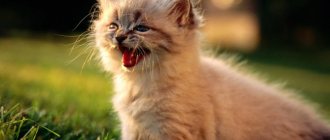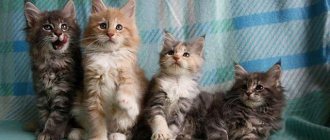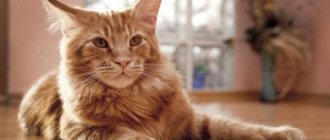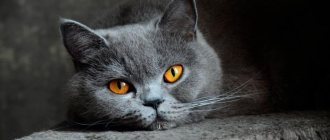Characteristics of an Oriental cat - character and habits
By their nature, Orientals are real stars because they want to be the center of attention. They will not wait peacefully while the owner goes about his business. Instead, the ori will readily jump onto his lap or spin around, demanding immediate attention.
At the same time, they are also extremely sociable - the breed is capable of making a variety of sounds from purring to meowing with different tonality and duration. Therefore, in the absence of proper attention, the furry pet is ready to drive the owner crazy with its demanding talkativeness.
Description of the breed
Like any representative of the species, an Oriental cat must meet a certain breed standard. Compliance with regulations is especially important for owners planning exhibitions and breeding of animals. But even someone who takes an Oriental just as a companion needs to understand what a pet should look like.
Appearance - what an oriental looks like
The head is of medium size and clearly proportional to the body. The shape resembles a wedge with straight lines. The wedge starts from the nose and gradually widens towards the ears. When viewed in profile, a slight convexity of the skull is determined. The forehead is flat. The ears are large, set wide and directed straight, at an angle in relation to the head. They are wide at the base, but the tips become pointed. The eyes are medium in size, almond-shaped and slightly slanted towards the nose. The classic shade is bright green. The nose is long and straight.
The neck is long, with a smooth transition into the line of the back. The body is long, with clearly defined muscles, but graceful. The limbs are slender and proportional to the body. The paws are oval shaped and quite small. The tail is thin and long, tapering towards the tip, reminiscent of a whip.
Today, according to their appearance, Orientals are divided into two types: classic and extreme. Extreme type cats have low-set ears and a very elongated muzzle.
Size
Normal height at the withers for an adult Oriental is considered to be between 23 and 25 cm. The body can be up to 90 cm long.
Weight
The average weight of an adult cat of the Oriental breed ranges from 3.7 to 4.5 kg. The normal weight for a cat ranges from 2.3 to 3.2 cm.
Wool
The breed is short-haired, the hair is fine and shiny. All fur should lie close to the body and be silky to the touch. There is practically no undercoat.
Colors
The classic colors of Oriental cats are:
- Ebony is a black shade of wool, also called black solid.
- Bronze - the shade resembles bronze, but a bright red color is acceptable, closer to red, while the paw pads and nose are soft pink.
- Lavender - this color is also positioned as lilac, the paws and nose are lavender, sometimes their shade is closer to pink.
- Havana is a classic chocolate color, can vary from light to dark brown, paws are brown-pink, nose is brown.
- Blue - a combination of gray-blue with a slight shade of silver, paw pads and nose are blue.
- Cream or fawn - includes fawn (beige coat) and cinnamon (shades of red or very light brown), paws and nose should be pink.
- Tortoiseshell or tri-color - it combines white, black and red wool.
- White is a unique color without a yellow tint, the paws and nose are soft pink, the eyes can be not only green, but also blue, or heterochromia may appear.
In addition, Ories can have a tabby color (the presence of spots, flats, marbled patterns, etc.) on top of the main shade of the coat.
Appearance of Oriental cats
The Georgian cat has a long body. Graceful lines create the image of an aristocratic animal. The tail is long. The head is large, triangular in shape. There is no smooth transition from the forehead to the nose. The cat's profile is even. The eyes are large, close-set, almond-shaped. Eye color is related to coat color.
Attention! Strabismus is considered a pathology of this breed. Big nose
There is no depression on the bridge of the nose. The kitten may have a slight indentation, but it will disappear over time
The nose is big. There is no depression on the bridge of the nose. The kitten may have a slight indentation, but it will disappear over time.
The ears occupy a sufficient area at the base, are large and widely spaced.
The length of the Oriental's limbs is above average. The bones are thin but strong. Oval shaped paws.
The coat is quite short, silky, and not prone to shedding.
Where did the Orientals come from?
Are Oriental cats hypoallergenic or not? How often do they shed?
Orientals can be called practically hypoallergenic, since their protein (which provokes allergies in humans) is synthesized to a lesser extent than in other breeds.
Shedding in eastern cats is moderate, and therefore does not cause any special problems. With proper care of the coat and sufficiently humidified air in the house, shedding will occur only in the autumn and spring seasons. At this time, the owner will need to increase the frequency of brushing the pet to several times a week.
Training and education
Raising a kitten should be done from the first day of being in the house. The pet must clearly understand what is possible and what is not. The main thing is to be consistent and be patient. You cannot allow a kitten to do things that will be prohibited in the future. Any deviations can be regarded as a call to action and all the efforts of previous training will come to naught.
The first lesson should start with the pet's name. Once the kitten learns the name, you can move on to more complex exercises.
Orientals have a very developed intellect, so they easily remember commands and sequences of actions. During classes and training, you should not raise your voice, much less physically punish your pet. Georgian cats are very touchy and will never work under pressure. For every correct action, you need to reward the kitten with affection, play or treats.
Playfulness
An eared cat with a Georgian nose will happily run after a ball, bring toys to its owner like a dog, and simply play with a new thing. She is active and mobile, loves to explore everything, and there is not a place in the house where she will not climb, informing the owner about it. Sometimes she can purposefully hide and watch as people are looking for her, and then suddenly jump out, inviting her to play. It will be useful for the future owner of an ori to purchase a gaming complex for the pet in order to engage the pet in an activity without your participation.
Features of behavior
The Georgian cat breed gets along well with people and other pets. They have the gift of subtly sensing the mood of the owner; cats are not aggressive, but if necessary they are able to stand up for themselves.
It is worth noting that hyperactivity is often found in representatives of the species, then any object in the house, including curtains, furniture, and decorative elements, can become a cat’s toy. You need to be prepared for this: prepare yourself mentally, arrange a spacious play area with various exercise equipment for your pet. Read here how to train your cat to behave well .
How to cope with loneliness
Orientals become strongly attached to their owner, and therefore his absence becomes very stressful. Long-term solitude or frequent absence of the owner due to work and other reasons can be a serious test for the pet. As a result, such a “Georgian cat” may not only end up in a state of severe stress, but also begin to get sick as a result of nervous exhaustion.
How to care for the skin of hairless cats
The main condition for caring for a cat is control. The skin is very delicate and the sun can burn the animal. The owner needs to ensure that the kitty does not overuse sunbathing.
In addition, it is recommended to bathe your Sphynx weekly. To prevent bathing from causing aggression, you will need to get used to it from childhood.
Important! Once every two days you need to wipe your pet with baby wipes. Comedones may form on the ridge and near the tail.
They cannot be squeezed out. This can cause inflammation on the animal's skin. To reduce the incidence of comedones, you need careful care of your cat’s skin.
Comedo clusters may form on the ridge and near the tail. They cannot be squeezed out. This can cause inflammation on the animal's skin. To reduce the incidence of comedones, you need careful care of your cat's skin.
Thus, Oriental cats are popular pets. They are often called Georgian cats because of their unique appearance. However, they have nothing in common with this nationality.
Oriental catteries
You can purchase an Oriental breed cat from one of the following nurseries:
- Nursery Avatar. Located in the Moscow region, in the city of Vidnoye.
- Salambo nursery. Located in Moscow. The nursery is registered with WCF. They are engaged in breeding Oriental and Siamese cats.
- Nursery JUNGLE. Located in Moscow. The nursery is registered with WCF and FIFe. They are engaged in breeding Oriental, Seychelles and Siamese cats.
- Nursery MASCOT. Located in Moscow. The nursery is registered with FARUS. They breed only oriental cats.
- Liberty World Nursery. Located in Moscow. The nursery is registered with WCF. They breed only oriental cats.
What is the difference between Orietal and Siamese cat breeds?
Orientals are often called rainbow cats: there are more than 300 variations of coat color. The Oriental breed has virtually no genetic diseases
What is the difference between Orietals and Siamese: Oriental and Siamese cat breeds are the same thing. These breeds have an absolutely identical description in the standards of the whole world and differ (depending on the felinological system) only in color. Most European systems distinguish the Siamese breed from the Oriental breed by the presence of a point color (or, more understandably, by the animal’s light, uncolored body and blue eye color). Oriental cats have a fully colored body and green eyes. There are no other differences, and the character is no exception; it is also very similar in these cats. Of course, we should not forget that each cat has its own unique character traits, just like a person, each cat is an individual.
In connection with what was written above, I will further use the name “Orientals” to mean both Siamese and Oriental cats. So, Oriental cats are very lively, active, curious, affectionate and sociable.
Orientals have a great need for human attention and communication with them. Oriental cats also love the company of tailed cats, regardless of whether it is a cat or a dog. However, they achieve the greatest harmony in relationships only with their own kind or with light-type cats that are similar in temperament.
Every minute while the owner is at home, they will entertain him with their agility, their elegant jumping, talking, playing with the mouse, or simply sharing a seat with him in front of the TV. Oriental cats really don’t like to be left alone, so they are ready to circle around a person most of the time
The greatest happiness for an Orika (as we affectionately call this breed) is play with the participation of the owner, no matter what you choose for the game, a teaser with feathers or a laser pointer, or maybe just decide to play hide and seek!
The owner of the oriental cannot sleep longer than the alarm clock, you will certainly be reproached for this, because the moment has come when you need to communicate, and you are still sleeping. And if you stay up late at the computer, your pet will definitely remind you of the routine and invite you to sleep. The talkativeness of this breed is, of course, a subject for another discussion. Owners know absolutely exactly what their pet is communicating. Orientals use a very large number of sounds and intonations in communication, and therefore, communication with them turns into a real dialogue.
The most striking feature of Oriks is their ability to greet their owner from work. It’s as if from the very moment you closed the door behind you, leaving for work in the morning, he, unhappy, sits there and has already looked through all his eyes, waiting for his beloved owner! He will definitely express his opinion that working for so long is harmful (for the Oriental’s psyche), and then he will check all the packages that you brought from the store in order to find out if there is anything for him.
Another inseparable trait from an oric is curiosity. Often it is so large that even the most cowardly Orik will crawl out of the lair to see what is going on “there”. By the way, this is why in their upbringing we often have to remind them that this cannot be done even today. And check the order in your closets, oh, that is, in his closets, of course! Open the door or drawer of the cabinet, in which perhaps something interesting, or maybe even tasty, is hidden... yes, an Orientalist definitely needs this!
Curiosity does not leave the orik even when guests come to the house. Not only does it not leave, it grows in them with every new guest! They select keys for each new person. The most striking feature of orics is the ability to make people who do not like cats at all and do not understand them fall in love with them.
Another important characteristic feature of Oriental cats is the ability to have several coordinate points in an apartment at once. It seems like he was just walking along with his tail and was so carried away by this, when suddenly a rumble comes from another room, and you turn around - he’s sitting here and washing himself! Imagine how problematic it is when there are several of them of the same color!
Oriental company is a great joy. With Orientals it is never boring to do troublesome household chores, because you don’t have to do anything alone. Truly, you are flying home, because he is bored and completely lonely there. This is exactly how you start to get excited about oriental cats and acquire a second oric for your company, sometimes then a third, and a fourth, etc.
Need for care
The Siamese Oriental is not a difficult breed to care for. Brushing them once a week is enough, and trimming their nails should be done once a month.
But they should be bathed a couple of times a year. More frequent bathing will be stressful for the pet, and is also not necessary for the cat itself. Ori do a good job of cleaning themselves. Also, on water treatment days, it is important for the owner to use only a special hypoallergenic shampoo.
The eyes of Orientals should be wiped daily using a cotton pad soaked in a light chamomile decoction. In addition, Ori's sensitive ears need to be cleaned with special products according to the veterinarian's recommendations weekly.
Maintenance cost
For a full and long life of an ori, the owner needs to understand not only how to maintain this cat, but also how much financial investment this will require.
Nutrition
The priority type of feeding is the use of dry food, and it is best to choose holistic and premium food. This is due to the sensitivity of Ori's digestion and their tendency to gain weight. The cost of monthly feeding with such food can cost the owner from 4 to 10 thousand rubles.
Feeding with natural products is also allowed, but the owner will have to strictly monitor the balance of the Oriental’s diet. And the price of such food will directly depend on the choice of products and their quality.
Veterinary
Carrying out standard vaccination according to the calendar will cost the owner of the ori in the amount of 1 to 3 thousand rubles. Any other costs are determined by the veterinarian according to their necessity.
Grooming
Caring for Oriental cats does not take much time, but a visit to the groomer can be a pleasant change for the pet and make life easier for the owner. One trip to the salon to the groomer can cost the owner of a fluffy beauty from 2 to 3 thousand rubles.
Exhibitions
Visiting exhibitions can cost from 5 to 30 thousand rubles. for participation in one event in Russia. The price varies according to the status of the exhibition and the title of the winners. But this amount does not include the cost of travel to the venue, accommodation and food for the owner of the oriental and his pet.
Breeding
Breeding Orientals requires experience. Finding a cat to breed is only half the battle. It is not a fact that the kittens will turn out “exactly” like the selected father. There are many nuances that experienced breeders know about.
Estrus in an Oriental cat is no different from other breeds. It is recommended to breed a breeding cat at least once a year and no more than once every six months. If a cat, in the presence of small kittens, asks for a cat again, then it is better to follow the pet’s lead and get her together again. The mating process must be approached very responsibly, taking into account the right time and the right partner. If show class kittens are needed, then both parents must also be of the same level. However, there is no guarantee that the entire litter will correspond to a given class. Only experienced breeders can determine the future fate of the litter - who is suitable for breeding or who “goes” to the so-called pet class (not suitable for breeding and participation in exhibitions). A cat's pregnancy lasts from 58 to 70 days. No special care is required for the animal, the only thing is that you will have to revise the nutritional standards by increasing the volume. You need to feed special food for pregnant and lactating cats. The belly begins to grow at 4 weeks, and already at 6–7 weeks you can feel the kittens moving. When the eighth week approaches, it is necessary to prepare the cat's place for birth. This should be a secluded, calm place. Childbirth in Orientals is not much different from others - she can lie quietly or run around the apartment, meowing. Labor can last from 2 to 6 hours. Kittens are usually surrendered at the age of three months
When choosing a small oriental, you should pay attention to its appearance. The kitten should look healthy and nimble. Eyes and ears should be clean, free of discharge, fur should shine in the sun.
When purchasing, the owner must present a birth certificate or pedigree. If there are no documents, then most likely the kitten is a mixed breed. If an animal is purchased for breeding, it is best to take it from a nursery. These are breed-class cats with good pedigrees. Animals are castrated between the ages of 8 and 12 months.
The eyes and ears should be clean, without discharge, the fur should shine in the sun. When purchasing, the owner must present a birth certificate or pedigree. If there are no documents, then most likely the kitten is a mixed breed. If an animal is purchased for breeding, it is best to take it from a nursery. These are breed-class cats with good pedigrees. The animal is castrated at the age of 8 to 12 months.
Pros and cons of the breed
Of course, the positive qualities of Oriental cats include:
- Exotic and aesthetically pleasing appearance.
- Friendly to people and animals.
- The ability to subtly sense the owner at the level of intuition.
- Highly developed intelligence.
- Ease of learning, up to the possibility of full training of the pet.
- Sociability and affectionate behavior.
- Fairly simple care.
- Lack of an extensive list of genetic pathologies.
- Hypoallergenic.
The disadvantages of the breed include:
- High price.
- Touchiness.
- The need for a lot of attention from the owner.
- Sensitivity of the digestive system.
- Poor tolerance to cold.
Potential Health Problems
Even though Georgians are famous for their longevity, they have inherited a whole list of genetic problems from the Siamese. Although by and large the breed is considered healthy and has strong immunity.
Common problems:
- liver amyloidosis;
- cardiomyopathy;
- congenital flat chest syndrome;
- gingivitis;
- retinal atrophy.
You also need to take into account that Orientals do not have an undercoat, so they are very sensitive to temperature changes and drafts.
History of the breed
Back in the 19th century, the first mentions of Siamese cats with a full solid color appeared, but until 1923 there was debate about whether they should be included in the breed standard. As a result, the British Siamese Club decided that this quality of the breed is not encouraged. From this moment, work began on the selection of future oriental cats. In the process of crossing with Siamese, Russian Blues, British Shorthairs, Abyssinians and even simple domestic cats were brought together.
As a result, in 1956, the American nursery imported the first representative of the oriental breed with a chocolate color. In 1958 they accepted the original form of the general breed standard and continued breeding it. Subsequently, breeders from America were able to achieve recognition of the solid-colored Oriental cat as a separate breed in 1977 and continued to work on creating new colors in the breed.
Already in 1995, bi-color (two-color) cats were able to gain recognition, and the breed began to be popularized around the world.
masterok
And indeed, from the outside it looks like a child’s drawing of a child who was trying to draw a cat. We’ve discussed so many options for cats here on the blog, but I still don’t know who these long-eared cats are. Some call them “Georgian” cats, others jokingly call them “elven” or “a cross between Dobby and a cat.” What kind of breed is this actually? Photo 2. The history of the origin of the Oriental breed began with their closest relatives - Siamese cats. True, both breeds have changed over time, so now their representatives are no longer as similar to each other as they were before. For example, on the face of Oriental cats there is never a black mask characteristic of Siamese, and their character is much softer. Photo 3. The ancestors of both of these breeds were first brought to England from Asia at the end of the 19th century, then the history of Oriental cats began, although their first images have been found in ancient Thai manuscripts. In 1896, for the first time, an exhibition was held, which included an oriental blue cat brought from Bangkok. True, after this a “boom” for Siamese cats began, and their relatives with a solid coat color were somewhat forgotten until the mid-20th century. In the 60s, British breeders began to breed a breed similar to the Siamese, but with a different coat color, and this is how the history of the Oriental cat breed as we know it began. Photo 4. The breed received its official confirmation a few years later, not only in England , but also in America (officially recognized in 1977). At first they were completely white cats, then with the Havana color, and then with the rest. But at the time of recognition, there were already more than 50 nurseries of these cats, and they were actively bred and purchased, despite the fact that there was no official confirmation. They first appeared in Russia in 1989, and immediately gained love and popularity among our compatriots, along with the Siamese. Since the origin of the Oriental cat is closely related to the Siamese, now they are classified as one group of breeds, have the same standards, and they can even be bred together. Photo 5. Cats of this breed are slender, muscular, with a long graceful neck, narrow hips and shoulders. The front legs are proportionally shorter than the hind legs, the paws are oval, small in size, and the belly is tucked. The tail is thin, pointed at the tip, very long. Photo 6. Psychology An oriental cat is very smart. If you have earned her respect and love, you will never feel betrayed by a cat.
The Oriental is very attached to a person, so she is offended if the owner, instead of petting, playing or just talking, is busy with his own business. Representatives of the Oriental breed, like all cats, are sure that the world was created for them, and therefore they will meow, trying to attract attention. Although their voice is quite pleasant and melodic, unlike Devon Rex or Ragdoll dogs. This is not a breed that will walk on its own, it needs a friend and playmate
This is not a breed that will walk on its own; it needs a friend and playmate.
Therefore, it is worth getting one for those who have more freedom with their time, like to play and don’t mind a “heart-to-heart conversation” - the cat loves to talk out loud and out loud. Those who love peace and quiet should consider another furry friend with a calm and quiet personality. Calm breeds include exotics, Persians, Abyssinian and Russian blue cats, as well as Scottish Straights and representatives of the Maine Coon breed. Photo 7. The Oriental cat seems to have telepathic abilities and easily senses the pain, desires and mood of the owner. Surprisingly, she can be taught some tricks, such as walking on a leash or fetching a ball. However, make no mistake, a cat will perform tricks if it wants to, and not under coercion. It is easier than representatives of other breeds to teach Orientals to go not even to the litter box, but, excuse me, to the toilet, to open the tap in the bathroom or kitchen so that drink water. In addition, they are also energy therapists - they lie down on a sore spot, curl up in your arms if you are tired. They get along well with children and do not forget, releasing their claws and fangs, even in the midst of games. Orientals react very friendly to the arrival of guests, charming and touching them. As for other pets, animals can make friends with them too. Photo 8. Photo 9. Photo 10. Photo 11. Photo 12. Photo 13. Photo 14. Photo 15. Photo 16. Photo 17. Photo 18. Photo 19. Photo 20. But this cat reminded me of this actor from “Star Wars” Photo 21. Or, for example, this fox: sources
Interesting facts about Oriental cats
It is useful for anyone planning to purchase an Oriental to learn about the interesting features of the breed:
- In the world of Orientals, they are often called rainbow cats. They received this nickname for their rich variety of colors.
- The lack of undercoat becomes a problem for the pet, and therefore in the cold season it is necessary to dress it warmly.
- Before the breed was fully recognized, many cat lovers called Orientals single-colored coffee-colored Siamese.
- Ori are jealous of their belongings and the place they choose. Almost any interference or attempt to take away a toy will cause resentment.
- This breed does not have the habit of releasing its claws and even scratching posts are in little demand among them.
How to choose a kitten
When buying and choosing an Oriental kitten, you need to pay attention first of all to age; you should not adopt a kitten under three months old. It is necessary to evaluate the conditions in which they are located
You need to play with the kitten and let its childish activity splash out. Small Orientals should not be kept in an enclosure or other confined spaces. Mobile individuals socialize well, adapt to new conditions, and have no mental or behavioral problems.
Asian cat breed.
Before taking an animal from the nursery, you need to assess its general condition. This can be done based on a number of external signs. Kittens should not have mats in their fur, especially long-haired Orientals - this indicates health problems. There are other factors to check:
- There should be no discharge on the eyes, nose, or ears.
- The stomach should not be bloated.
- The animal must have all the required documents (birth certificate, passport, pedigree).
The lack of documents indicates the risk of acquiring a mestizo rather than a purebred individual. By hiding documents, the breeder is trying to distort the history of the kitten's origin.
How much does an oriental cat cost?
Specialist breeders in nurseries will help you determine how much an Oriental cat costs.
It is worth paying attention to nurseries that are engaged in breeding the breed class of Oriental breeds that have a rich pedigree. Such an animal will cost from 100 thousand rubles and more
Those kittens that are not planned for breeding will cost their owner 40-60 thousand rubles. The final price of the animal depends on the coat color and compliance with the breed class. The cheapest animals are those that have been culled - they are not allowed to be mated and do not participate in exhibitions, so the cost will be 25-30 thousand rubles.
Most breeders offer already sterilized individuals. If this does not happen, many breeders require their animal to be castrated later, at the age of 8-12 months. This condition may be specified in a contract, the violation of which may lead to legal proceedings.
